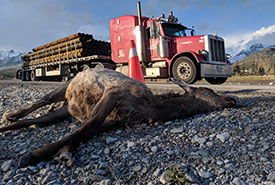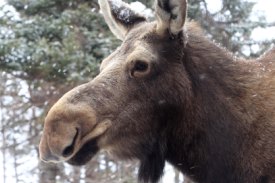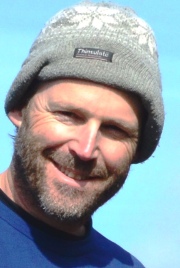The places we protect for nature must be connected

An elk killed by a vehicle in Alberta's Bow Valley. (Photo by Kelly Zenkewich, Yellowstone to Yukon)
Written by Dan Kraus, Wildlife Conservation Society Canada, Karen F. Beazley, Dalhousie University, Jodi Hilty, Yellowstone to Yukon Conservation Initiative, Christopher J. Lemieux, Wilfrid Laurier University and Pam Wright, University of Northern British Columbia
There is growing recognition of the critical importance of keeping and restoring conservation corridors. But on a planet where people’s influence is everywhere, many ancient wildlife migrations and movements are at risk. We have now altered three-quarters of the Earth’s terrestrial ecosystems. While Canada’s North still holds some of the planet’s last intact wild areas, much of our southern landscapes have been transformed into cities, farms and roads, fragmenting natural habitats into smaller and smaller pieces. A robust national network of conservation corridors is essential in an age of extinction and climate change.
Parks and conservation lands have long been seen as the one-stop solution to the loss of nature. Our national and provincial park systems are largely based on protecting samples of different habitats from across the country. Saving all the pieces of nature is an important conservation goal, as many critical ecosystems in Canada remain inadequately protected.

Moose in Cookville, NB (Photo by Mike Dembeck)
But parks can only do so much to save nature. Most will never fully encompass all the habitats needed by wildlife like moose, mountain caribou or pronghorn. And we could never create a park that includes all the habitats needed by species like Arctic tern or American eel, whose migrations cover vast areas of our planet. Every one of the places we set aside for nature will always be too small for some of the wildlife we are trying to protect.
The world is changing fast for wildlife. Not long ago, all of Canada’s protected and conserved areas were pieces of a larger whole. But many now exist as isolated fragments of nature. In satellite images, the boundaries of parks like Riding Mountain in Manitoba or Point Pelee in southern Ontario are distinctly framed by the human-altered landscapes that surround them — islands of green in a sea of roads, cities and farms.
On top of habitat fragmentation, wildlife is now being forced to adapt to the new challenges brought on by climate change. While many animals and even plants can shift their ranges, this becomes increasingly difficult, and even impossible, in landscapes that are dominated by people.
Canada has pledged to protect 30 per cent of our lands and oceans by 2030. But that goal can’t be limited to protection. For conservation to be truly effective, that goal must also strive to keep nature connected through a robust national network of nature corridors.
The Canadian Council on Ecological Areas released a report that helps set a vision for what this nature network could be. It brings together new ideas and examples from across Canada of how we can keep nature connected. It identifies that Canada’s diverse conservation community, including all levels of governments, conservation organizations and local communities, must start to think outside of the box of park boundaries. We must listen to Indigenous Knowledge about wildlife, and we must make connectivity conservation a standard practice in agriculture, forestry, mining, transportation and urban planning.
Fortunately, we know many of the solutions that are needed to connect nature. From the work of the Yellowstone to Yukon Conservation Initiative in maintaining a continental conservation corridor for wildlife in the Rocky Mountains, to the efforts by the Nature Conservancy of Canada to create a corridor for “moose sex” in Atlantic Canada, to a national Key Biodiversity Areas initiative that is identifying critical wildlife migratory stopovers where wildlife aggregates, there are thousands of Canadians already working to keep Canada’s nature connected.
While we know many of the solutions, it will be a question of setting priorities. In many places, we soon need to choose which parts of nature will be connected, and which parts of nature may be cut off and destined to eternal isolation.
Every one of the places we protect for nature relies on how we manage its surrounding areas. As natural resource development continues to press north, opportunities to maintain conservation corridors in Canada’s boreal forests are dwindling. In southern Canada, continued habitat fragmentation threatens to further isolate the natural areas that we have managed to conserve, and restoration options are disappearing. With the push toward ambitious national conservation goals, there will never be a better time to create conservation corridors.
The loss of wildlife connectivity is the result of fragmentation by a thousand cuts. In a world that is rapidly changing through habitat loss and climate change, we need to develop and implement a vision of wildlife connectivity across our country. Restoring that connectivity will require thousands of acts of ecological healing across our country that range from tree planting to highway underpasses to dam removal. And the healing is not solely for wildlife. Ecological connectivity is important to social connectivity, providing networks for cultural and recreational activities, solace, healthy relationships and well-being, especially for Indigenous Peoples and their food and ways of life. Every one of us that lives and works in the vast intervening lands between our protected and conserved areas has a role to play.
This blog originally appeared on the Wildlife Conservation Society Canada's internal blog and is reposted with permission.


